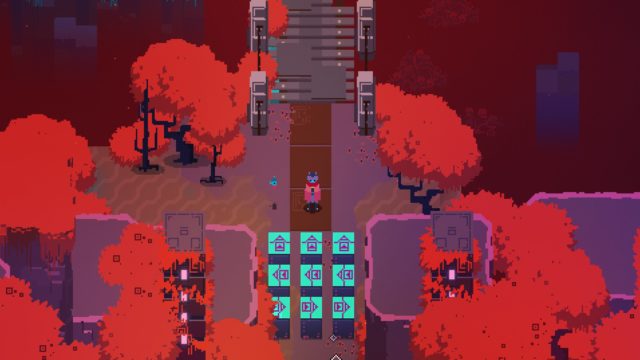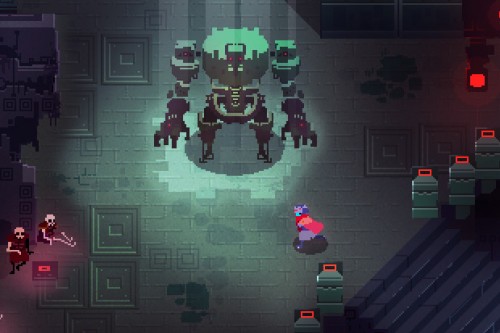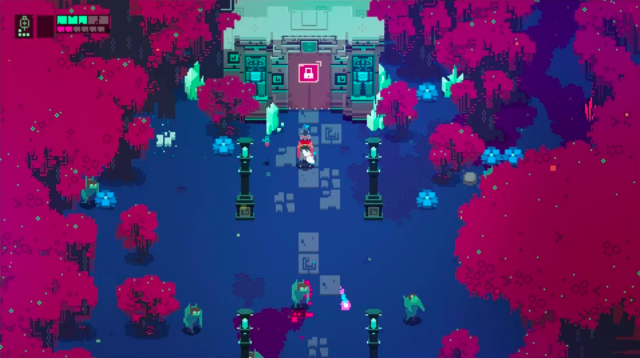Elegant style; brilliant, from-the-heart premise; fresh gameplay mechanics
Challenge can be steep, even on the “newcomer” mode; both plot and some gameplay elements can be confusing
In 2013, a developer named Alex Preston set out to develop an old-school title in the vein of The Legend of Zelda: A Link to the Past and Diablo, with a post-apocalyptic style reminiscent of the 1984 anime classic Nausicaä of the Valley of the Wind. Preston saw this project as more than just a hobby; born with a congenital heart disease and beset with a lifetime of medical challenges, Preston aimed to craft a character facing a terminal disease.
Preston sought out funding from Kickstarter, which succeeded far beyond expectations: he was able to raise more than $600,000 (his original target was $27,000). One of his promises in going over his initial budget was to bring the game to multiple platforms. In 2016, those platforms included PC, PlayStation 4, and Xbox One. And now, they include Nintendo Switch.
Hyper Light Drifter – Special Edition, available today through the eShop, runs $19.99 at the time of this review. The Special Edition includes content currently exclusive to Switch, including a new challenge mode as well as a few new pieces of equipment. The game is a retro-style action RPG with old-school visuals meant to imitate elements of 8-bit and 16-bit style running on more powerful hardware (the game, in fact, boasts 60 frames per second). Both the music and the graphics scream 1980s, with synth tunes that are vaguely reminiscent of other ’80s homages.

Appropriate for a game created by a development team called Heart Machine, one doesn’t have to look far to see the heart in this game. This isn’t just a love letter to old-school gaming: it’s a real attempt to write a new chapter in the history of that gaming. Yes, there are elements of other games in here, but it doesn’t feel derivative. Quite the contrary, it’s a fresh take on action RPGs that is distinctive from many of the games that came before. From the haunting opening montage, it’s clear that this game is going somewhere very different.
It’s also a game with a ton of challenge. For one, Hyper Light Drifter uses only a bare minimum of words to get through the game’s minimal opening tutorial, and almost none thereafter. Dialogue is conveyed through still frames, as are quest objectives. Shops in the game’s hub world sell wares identified only by images showing what the upgrades do, with no captions or explanations.
That can lead to some confusion. There is obviously a big plot here, but even on repeated viewings of the opening cinematic it’s not easy to parse together exactly what that plot is. Likewise, the stories of those people players encounter can be hard to fully understand, as well as the player’s objectives. Even the name of the protagonist isn’t explicitly clear; according to sources online, it’s Drifter. Some Googling can help yield an understanding what is going on and how to play the game, but that has to happen above and beyond what the game itself provides.

The game has two difficulty levels: a more “forgiving” newcomer version that allows for unlocking some achievements, and an “intended” normal difficulty setting that allows for unlocking all achievements. Make no mistake about it: both difficulty levels are hard, especially at the beginning. The normal difficulty borders on brutal, especially when fighting large groups of enemies. The newcomer difficulty is obviously less difficult, especially after some time, but even in that mode the early game is liable to kill a new player more than a few times.
A major reason for the difficulty is in the game’s core design. The main character’s attacks all have timing considerations that can expose the player to attack or even knockdown, while hitting an enemy doesn’t necessarily stop or stun the enemy. A player, for example, can be hit in mid-swing, and attempts to heal can be interrupted and even canceled in combat. That means that pinpoint timing and positioning is paramount, and failing to do so often results in swift death.
Another consideration is the weapons loadout. Players start with access to a melee weapon and a limited-charge ranged weapon. The melee attacks power up the ranged weapon, while shooting, obviously, depletes it. This is a great system, but it also presents plenty of challenges. Imagine being surrounded by a swarm of moving, shooting enemies, trying to glance up at the ammo bar to see if it’s empty, all while running around deciding whether to swipe or shoot (or risk a heal). It’s a lot going on, and it’s not hard to get mixed up doing it.
Yet another challenge is that the game isn’t strictly linear. There are multiple ways a player can go from the hub world, with each of them sporting various levels of difficulty. Determining when to back down and try a different area is a matter of trial-and-error.

That all said, there are some small things that help to mitigate the difficulty at least a little. One is a robust autosave system that usually saves things within a minute or two of death. That means that, while a player may die (and die often), one will usually respawn not too far away.
Two, the game has an upgrade system that makes the game incrementally a little easier. Players will have the chance to acquire new attacks and augment existing abilities, all of which collectively help to make the Drifter a more formidable fighter, yet still one that can get struck down.
Three, the game allows for two-player couch co-op. Like some other things in the game, how to enable this is not entirely clear, but essentially it involves having two Joy-Cons on, enabling co-op from the menu, and having player two hit the + / – on their respective Joy-Con. The game also doesn’t tell you this, but enabling a second player takes one bar of health from the main player, and if the main player dies, it’s respawn time, regardless of the second player’s situation. The co-op mode, by virtue of splitting up the Joy-Cons, also necessitates some changes in the controls that take a little getting used to compared to using both Joy-Cons together (the game, at least, does have a decent control explanation in the menu) but once those hurdles are mastered, having a second player becomes very helpful, especially when battling hordes of enemies.
A final note: Hyper Light Drifter, more than the average game, truly rewards practice. Over time, many of the title’s difficulties become, if not easier, at least a little more manageable. And little victories can be really satisfying, whether it’s a little thing like dodging in and out of a cluster of enemies or toppling one of the game’s large bosses with just one health bar left.
So, what to make of this game overall? That’s going to be a matter of taste. If you’re the kind of gamer who loves old-school games, post-apocalyptic style, and gameplay that really challenges your reflexes, Hyper Light Drifter – Special Edition is absolutely the game for you. If, on the other hand, you prefer your RPGs to be a little more slow and steady, this may incite a little more controller rage than you’d like, regardless of the game’s beautiful trappings. Even then, though, it’s hard not to like what the developer has done here, and for that, this is definitely a game worth a look.
Nintendojo was provided a copy of this game for review by a third party, though that does not affect our recommendation. For every review, Nintendojo uses a standard criteria.




 ShareThis
ShareThis





